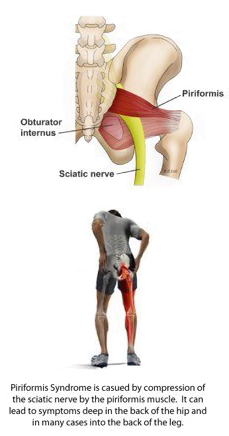Piriformis syndrome is a cause of posterior hip and leg pain that occurs when the sciatic nerve is compressed or irritated by the piriformis muscle. The piriformis muscle is a flat, band- like muscle located in the buttocks near the top of the hip joint. This muscle is important because it stabilizes the hip joint and lifts and rotates the thigh away from the body. This enables us to walk, shift our weight from one foot to another, and maintain balance. It is also used in sports that involve lifting and rotating the thighs. The sciatic nerve is a thick and long nerve in the body. It passes alongside or goes through the piriformis muscle, goes down the back of the leg, and eventually branches off into smaller nerves that end in the feet. Nerve compression can be caused by spasm of the piriformis muscle. As the sciatic nerve becomes irritated it can lead to symptoms such as pain, tingling and numbness along the path of the sciatic nerve, including into the buttocks and down the back of the thigh and lower leg. Physical therapy is highly recommended in treating piriformis syndrome.
